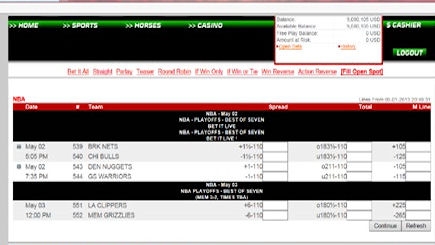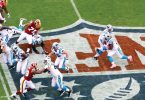This article first appeared in the Jul/Aug 2013 issue of World Gaming magazine.
WGM’s sports betting guru Big Jim explains everything there is to know about sports betting in the US

From wagering on cock-fights many centuries ago to opening an online account in the modern era, betting on sports has long captured imaginations the world over. Modern day sports betting is big business and the range of events and exotics available to bet on is as wide as America’s Grand Canyon.
Sports betting these days can generally be broken down into English, European or American styles and although the European style is winning the war globally – betting on decimal prices will be the norm in the future – the American wagering system is an interesting one to look at. In fact, this system has been responsible for the rise of a number of different bet types across numerous sports globally.
Many of our readers would be familiar with the old English system which is based on odds and still widely used by bookmakers in England. For example, if you back a team at 5/1 and it wins, you win $5 for every dollar invested and also have your initial $1 stake returned. So for every $1 invested you are returned a dividend of $6. Internationally the English model has now moved to the decimal system (known as the European format) so those 5/1 odds would be listed as $6.00. The result is still the same but the return of your investment is included in the price.
The American format is a little more complicated, being based around the winning return or stake of $100. No-one is quite sure exactly how this came to be but it probably has something to do with the fact that sports bettors tended to bet in multiples of $100 rather than multiples of $1.
Under this format, the standard handicap bet for both teams in any given sport would be booked at -110. This means that you have to risk $110 dollars to win $100 and equates to $1.91 in decimals or 10/11 in odds. Likewise, -200 means that you need to invest $200 to win $100 which equates to $1.50 in decimals or 1/2 in odds.
 What if something is paying even money or higher? Now the minus sign changes to a plus sign. +100 means that you will win $100 for a $100 investment, which equates to $2.00 in decimal or 1/1 (or evens) at odds. +500 means that you would receive $500 for a $100 investment, which equates to $6.00 in decimals or 5/1 in odds.
What if something is paying even money or higher? Now the minus sign changes to a plus sign. +100 means that you will win $100 for a $100 investment, which equates to $2.00 in decimal or 1/1 (or evens) at odds. +500 means that you would receive $500 for a $100 investment, which equates to $6.00 in decimals or 5/1 in odds.
Most modern sports betting websites actually give you the option of using any of these three wagering systems. It doesn’t matter which you use but we recommend whichever makes the most sense to you because you will make less mistakes. Using an unfamiliar system only creates confusion.
Having said that, there is an easy way to convert a minus total to a decimal in US sports. Let’s say a team is booked at -130. All you need to do is divide 100 by 130 on a calculator which will give you .769. Round it up to the nearest cent and the decimal equivalent to -130 comes to $1.77.
It seems like a strange way to do things and in the future the European format will be the most common but there remains some very significant aspects of modern day sports betting that have their history in US sports betting culture.
As an aside, the irony behind the US having developed so much of today’s legal sports betting practices can’t be overlooked – organized crime has traditionally played a big role in bookmaking in America and still does today given that sports betting remains illegal in the majority of states.
Traditionally, the English style of bookmaking revolved around betting on a team to win or lose, or in sports like football and cricket to win, lose or draw. The American format has always tended to revolve around a handicap system. This is what Americans refer to as the “spread”, but in other cultures it is more commonly referred to as the “line”. The spread handicaps one team and gives the other team a head start. What this does is create a more even betting market based around an even money market with a commission for the bookmaker thrown in. So, for example, if the L.A. Lakers are playing Boston the Lakers might be considered a 7.5 point favorite. This would mean that they have to win by eight points to “cover the spread”. Boston, on the other hand, could still lose the game by up to seven points and still “cover the spread”. So traditionally the market would look like this.
LA Lakers -7.5 @ -110
Boston +7.5 @ -110
Bookmakers would quote you a price of a 7.5 spread at -110 each of two meaning that both sides are paying -110 at the handicap. This style of betting works perfectly with a number of sports, especially basketball and football. In the US it is by far the most common way of betting, and betting on either team to win the game straight out is known as betting the “money line” which will give a price for both teams to win the game outright.
In baseball and hockey they bet the “spread” which usually gives the underdog a 1.5 run or 1.5 goal head start (this can be larger if one side is a massive favorite, but it is unusual). In baseball it is described as the “run line” and in hockey it is called the “goal line”. This is a form of handicap betting as well but isn’t as neat as football and basketball and it is unusual that you will find both teams at exactly -110. “Money line betting” is far more prominent on baseball and hockey because the handicap system doesn’t work as well due to the relatively low scoring of both games.

The other style of betting that is huge in the US is betting on the “totals”. In American football and basketball the “totals” is the total amount of points scored in the game by both teams combined. That means you are betting on whether the game will be high scoring and offensively dominated or low scoring and defensively dominated. This is a great way to bet if you think the game spread is around the right mark but still want some action.
In baseball and ice hockey they also bet the “totals” which is determined on how many runs or goals are scored in the game by both teams. Again, because these two sports have lower scores in their games the science isn’t as exact as it is in football and basketball so in the betting you will usually find that one of the two options offered (over or under the “total”) is shorter than the other. Handicap betting and betting on the amount of scoring in a game has become a big part of sports betting across the globe and we can thank the Americans for developing this system.
For the uninitiated the American style of quoting prices can seem a little confusing but thankfully the need to know the different formats of wagering is becoming less necessary. As I noted earlier, most modern day sports betting websites are in the business of making it easy for you to understand the bets they have on offer. It’s an interesting part of sports betting history, however, and it’s always good to shock Americans by showing that you understand their betting system.







